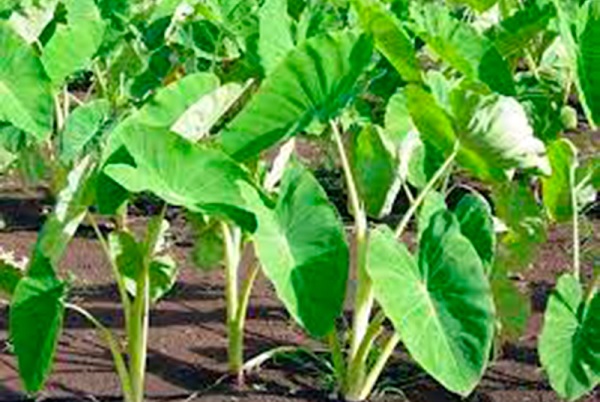Cocoyam farmers remain the main custodians of production and varietal information of the crop in West Africa (Acheampong et al., 2015; Ramanatha et al., 2010).
Most varieties currently cultivated in the sub-region are believed to be landraces introduced by the Portuguese and or West Indian missionaries (Doku, 1966; Onokpise et al., 1999; Ramanatha et al., 2010).
Currently, there are two commercially cultivated varieties (Acheampong et al., 2015) from the earlier reported.
In Ghana, cocoyam is generally grown by smallscale farmers and cocoyam farms under intensive management and are highly limited.
Cocoyam leaf is produced on a subsistence basis and pickers who are not farmers dominate its harvesting and marketing.
Although cocoyam production started increasing in 2006, the annual growth rate has been decreasing currently.
Despite the usefulness of cocoyam and cocoyam leaves, the cocoyam sector in Ghana is beset with challenges.
![]()
Cocoyam leaves
Some of these challenges are the alarming rate of forest degradation sector (as the bulk of cocoyam grows in forest areas) and the lack of improved varieties for commercial cocoyam and cocoyam leaf production.
Decreasing rainfall and poor soils as well as post-harvest losses have also been identified as some of the limitations besetting the cocoyam sector.
Generally, farmers just select the marketable leaves based on the desirable qualities (such as tender, fresh and disease-free leaves) and tie them in bundles.
There is virtually no processing of cocoyam leaves at the farmer level before marketing except for sorting and cleaning.
After selection and tying of cocoyam leaves in bundles, farmers either package them in baskets or jute sacks.
Only five per cent of farmers package cocoyam leaves in polythene bags.
The majority (93 per cent) of farmers sold their cocoyam leaves immediately after harvesting.
A majority (76 per cent) of the farmers sold at the main market in the Fanteakwa District in the Eastern Region.
Preservation of cocoyam leaves at the farmer level was done by either keeping them in an airy place (30 per cent) or leaving them in the open overnight (70 per cent).
Cocoyam leaves stayed fresh within three days after harvesting at the farmer level.
Beyond this period, farmers were discouraged to sell.
Excessive heat was the main factor causing the deterioration of cocoyam leaves at the farmer level (Quaye et al, 2010).
Best practices
● Small-scale farmers need to be well organised into groups for efficient access to production credits and markets.
● Policy directions should be focused on conscious reorientation and mobilisation of cocoyam farmers into well-organised groups.
This will also facilitate effective dissemination of improved technologies in order to optimise the economic and utilisation potential of cocoyam.
● Currently, small-scale farmers are generating modest profits on cocoyam cultivation.
To increase profit levels from cocoyam cultivation, promotion of labour efficient farming technologies are recommended.
Use of labour efficient farming practices will significantly reduce production cost and increase profits from cocoyam farming.
● High cost of transportation of raw agricultural produce and cocoyam in particular from the farm gate to consumption centres could also be significantly reduced through post harvest processing and value addition at the farm gate.
● Crop improvement research needs to use agro-ecological approaches that develop new varieties to fit into local niches, placing a premium on farmer, trader and consumer participation in varietal breeding.
Interventions
● Leaves could be processed into purees for end uses such as in preparation of soups and sauces, as well as in novel products to tap their nutritional value.
● Leaves could be processed into flours which could be incorporated into snack foods.
● Studies on appropriate packaging techniques could be undertaken to package ready-to use (pre-sliced) leaves.
This would aid address the time constraints coupled with irritations on the skin associated with the preparation of palaver sauce.
● The product(s) may also be exported to serve the needs of expatriates from West Africa (and other cocoyam growing areas) who have to substitute their cocoyam leaves with other vegetables in preparation of traditional delicacies abroad.
The high nutritional value of cocoyam leaves could be explored in new markets in Europe and the United States of America, to substitute for other vegetables such as spinach, with such convenient product.
The writer is a Food technologist, CSIR-Crops Research Institute.
nyarkofaust@yahoo.com

